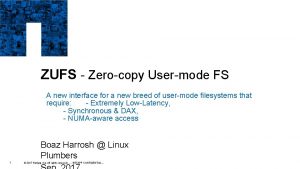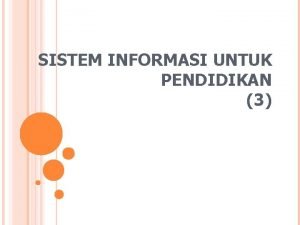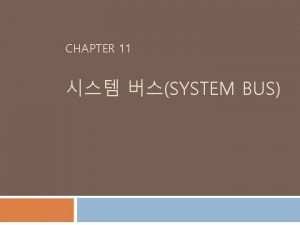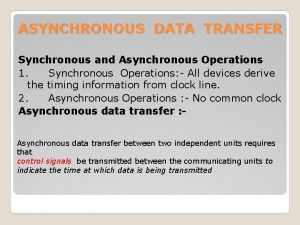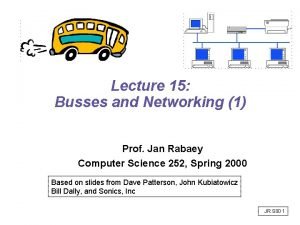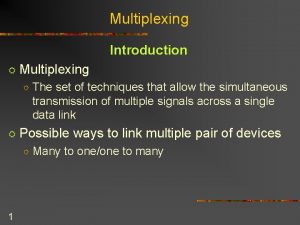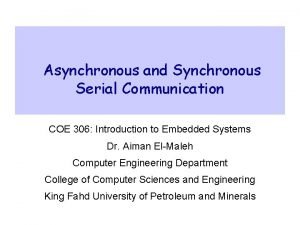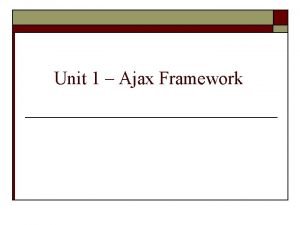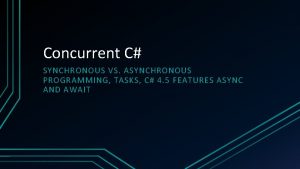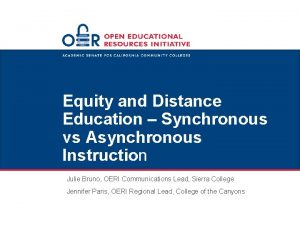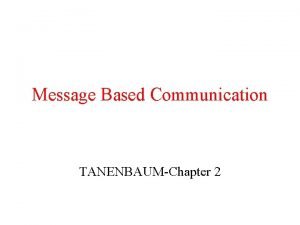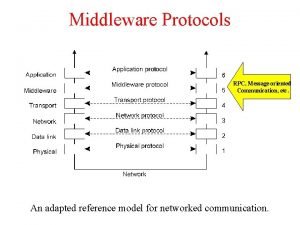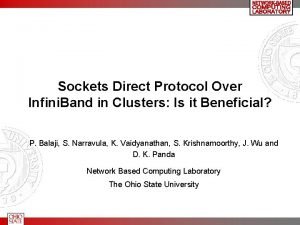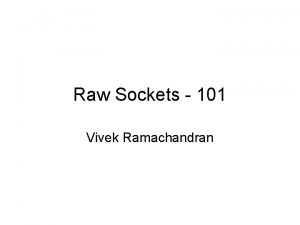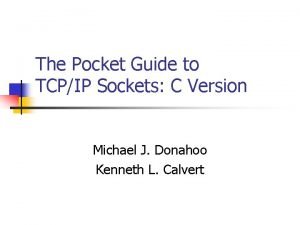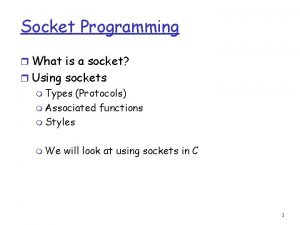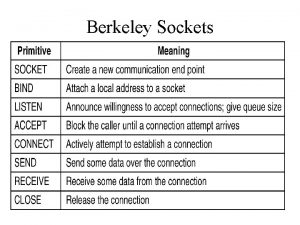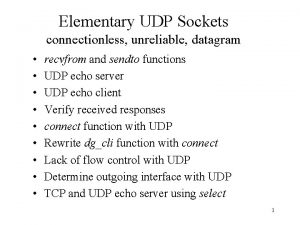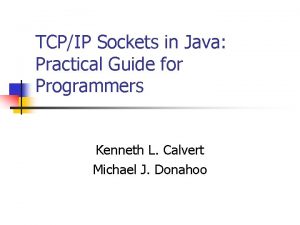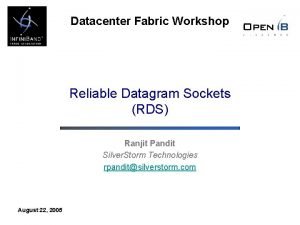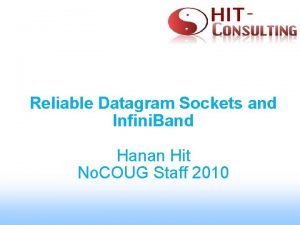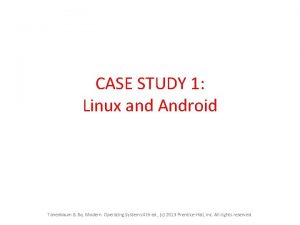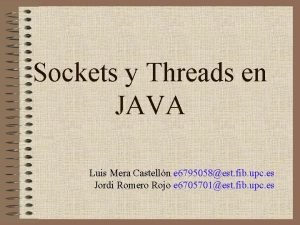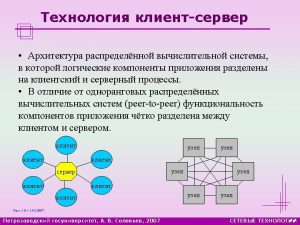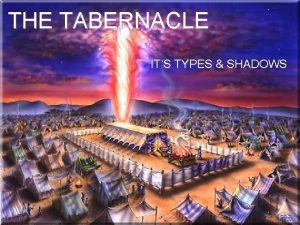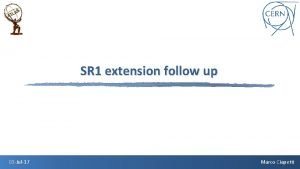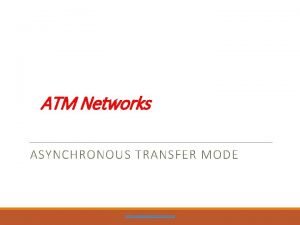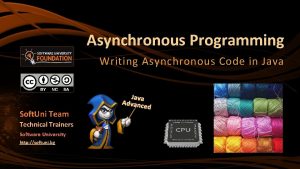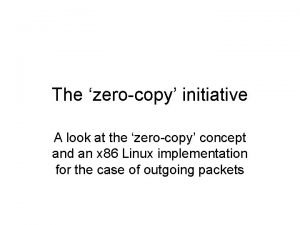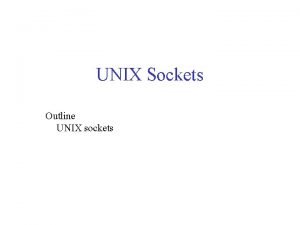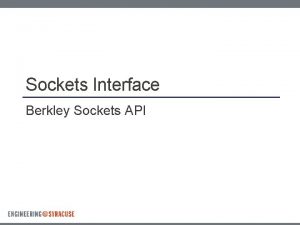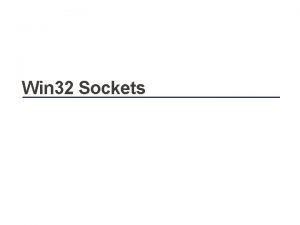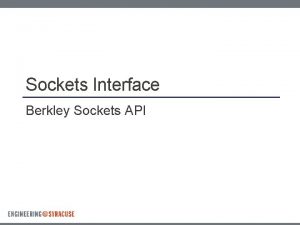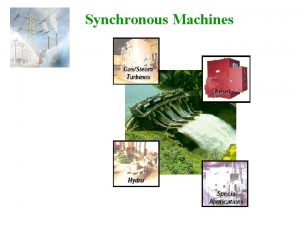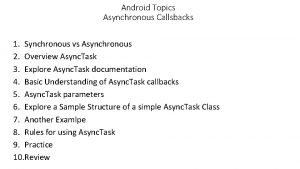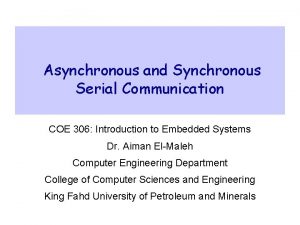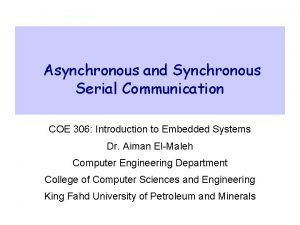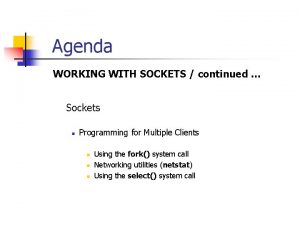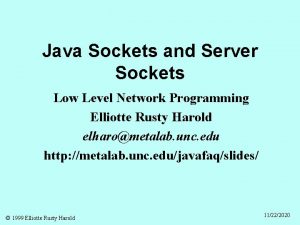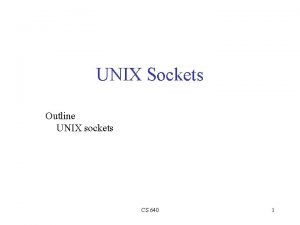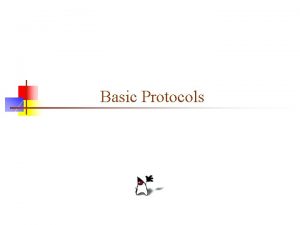Asynchronous Zerocopy Communication for Synchronous Sockets in the




































- Slides: 36

Asynchronous Zero-copy Communication for Synchronous Sockets in the Sockets Direct Protocol over Infini. Band P. Balaji, S. Bhagvat, H. –W. Jin and D. K. Panda Network Based Computing Laboratory (NBCL) Computer Science and Engineering Ohio State University 04/25/06 Pavan Balaji (The Ohio State University)

Infini. Band Overview • An emerging industry standard • High Performance – Low latency (about 2 us) – High Throughput (8 Gbps, 16 Gbps and higher) • Advanced Features – Hardware offloaded protocol stack – Kernel bypass – direct access to network for applications – RDMA operations – direct access to remote memory 04/25/06 Pavan Balaji (The Ohio State University)

Sockets Direct Protocol (SDP) App #1 App #2 App #N Sockets Interface • Hijack and redirect socket calls Traditional Sockets Direct Protocol TCP IP • High-Performance Alternative to TCP/IP sockets for IB, etc. • Application transparent – Binary compatibility (most cases) • Utilizes IB capabilities Device Driver Offloaded Protocol Advanced Features High-speed Network – Offloaded Protocol – RDMA operations – Kernel bypass 04/25/06 Pavan Balaji (The Ohio State University)

Sockets APIs Supported by SDP Synchronous Sockets Asynchronous Sockets Extended Sockets (OSU Specific)* Communication Synchronous Asynchronous Operations Outstanding At most one More than one SDP Implementations BSDP, ZSDP, BSDP, ZSDP AZ-SDP BSDP, ZSDP Existing Applications Most Few Very few Potential for Performance Limited High (Portions of this table have been borrowed from Mellanox Technologies) * RAIT 05: “Supporting i. WARP compatibility and features for regular network adapters”. P. Balaji, H. –W. Jin, K. Vaidyanathan and D. K. Panda. RAIT Workshop; in conjunction with Cluster ‘ 05 04/25/06 Pavan Balaji (The Ohio State University)

Presentation Layout § Introduction and Background § Understanding Asynchronous Zero-copy SDP § Design Issues in AZ-SDP § Performance Evaluation § Conclusions and Future Work 04/25/06 Pavan Balaji (The Ohio State University)

Buffer-copy SDP (BSDP) • Several buffer-copy based implementations of SDP exist SDP Buffer App Buffer – OSU, Mellanox, Voltaire • HCA offloads transport and network layers SDP Data Message Data Sink SDP Buffer Data Source • Copy overhead still present SDP Buffer App Buffer SDP Buffer ISPASS 04: “Sockets Direct Protocol over Infini. Band in Clusters: Is it Beneficial? ”. P. Balaji, S. Narravula, K. Vaidyanathan, S. Krishnamoorthy and D. K. Panda. IEEE International Conference on Performance Analysis of Systems and Software (ISPASS), 2004. 04/25/06 Pavan Balaji (The Ohio State University)

Zero-copy SDP (ZSDP) • Implemented by Mellanox – RDMA Read based design • Benefits of zero-copy • Limited by the API of Synchronous Sockets – At most one outstanding communication request – Control message latency (50% time for 16 K message) • Intolerant to Skew 04/25/06 App Buffer send() SRC AVAIL Application Blocks App Buffer Send Complete App Buffer GET COMPLETE send() SRC AVAIL Application Blocks Send Complete Pavan Balaji (The Ohio State University) App Buffer GET COMPLETE Data Source Data Sink

Asynchronous Zero-copy SDP (AZ-SDP) • Basic zero-copy communication is synchronous – Data communication accompanied by control messages – Communication will be latency bound • Asynchronous Zero-copy SDP – Utilize the benefits of asynchronous communication (more than one outstanding communication operation) – Maintain the semantics of synchronous sockets (application can assume that it is using synchronous sockets) – Objectives: Correctness, Transparency and Performance – Key Idea: Memory protect buffers 04/25/06 Pavan Balaji (The Ohio State University)

AZ-SDP Functionality • Send returns as soon as communication is initiated – Application “thinks” communication is synchronous • Memory unprotected after communication completes App Buffer 1 send() Memory Protect send() App Buffer 2 Memory Protect SRC AVAIL Get Data Memory Unprotect App Buffer 1 • If application touches buffer – Communication complete: Great! – Else PAGE FAULT generated 04/25/06 Pavan Balaji (The Ohio State University) App Buffer 2 GET COMPLETE Data Source Data Sink

Presentation Layout § Introduction and Background § Understanding Asynchronous Zero-copy SDP § Design Issues in AZ-SDP § Performance Evaluation § Conclusions and Future Work 04/25/06 Pavan Balaji (The Ohio State University)

Design Issues in AZ-SDP • Handling a Page Fault – Block-on-Write: Wait till the communication has finished – Copy-on-Write: Copy data to internal buffer and carry on communication • Handling Buffer Sharing – Buffers shared through mmap() • Handling Unaligned Buffers – Memory protection is only in the granularity of a page – Malloc hook overheads 04/25/06 Pavan Balaji (The Ohio State University)

Handling a Page Fault • Memory protection needed to disallow the application from accessing an occupied communication buffer • Page fault generated on access – Number of page faults generated are application dependent • Two approaches for handling the page-fault – Block on Write – Copy on Write 04/25/06 Pavan Balaji (The Ohio State University)

Block-on-Write • Optimistic approach to avoid blocking for communication – ZSDP blocks during the communication call – AZ-SDP delays blocking • Advantage: – Zero-copy communication send() Memory Protect App Buffer 1 SRC AVAIL Memory Unprotect Application touches buffer PAGE FAULT generated Get Data Block App Buffer 1 – SDP specification compliant • Disadvantage: GET COMPLETE – Not skew tolerant 04/25/06 Pavan Balaji (The Ohio State University) Data Source Data Sink

Copy-on-Write • Enhances the functionality of Block-on-Write – Does not blindly block App Buffer 1 send() Memory Protect Memory Unprotect • Advantage: – Zero-copy communication when possible Application touches buffer PAGE FAULT Atomic Lock generated Successful Atomic Lock Copy to Failedtemp. buffer Block – Skew tolerant when receiver is not ready SRC AVAIL Atomic Lock SRC UPDATE GET COMPLETE • Disadvantage – Not SDP specification compliant 04/25/06 Pavan Balaji (The Ohio State University) App Buffer 1 Data Source Data Sink

Presentation Layout § Introduction and Background § Understanding Asynchronous Zero-copy SDP § Design Issues in AZ-SDP § Performance Evaluation § Conclusions and Future Work 04/25/06 Pavan Balaji (The Ohio State University)

Experimental Test-Bed • 4 node cluster – Dual 3. 6 GHz Intel Xeon EM 64 T processors (2 MB L 2 cache), 512 MB of 333 MHz DDR SDRAM – Mellanox MT 25208 Infini. Host III DDR PCI-Express adapters (capable of a link-rate of 16 Gbps) – Mellanox MTS-2400, 24 -port fully non-blocking DDR switch 04/25/06 Pavan Balaji (The Ohio State University)

Throughput and Comp. /Comm. Overlap • 30% improvement in the throughput • Up to 2 X improvement in computation/communication overlap tests 04/25/06 Pavan Balaji (The Ohio State University)

Impact of Page-faults • When application touches the communication buffer very frequently, PAGE FAULT overheads degrade AZ-SDP’s performance 04/25/06 Pavan Balaji (The Ohio State University)

Presentation Layout § Introduction and Background § Understanding Asynchronous Zero-copy SDP § Design Issues in AZ-SDP § Performance Evaluation § Conclusions and Future Work 04/25/06 Pavan Balaji (The Ohio State University)

Conclusions and Future Work • Current Zero-copy SDP approaches: Very restrictive • AZ-SDP brings the benefits of asynchronous sockets to synchronous sockets in a TRANSPARENT manner • 30% better throughput and 2 X improvement in computation-communication overlap tests • Analysis with applications and large-scale clusters • Integration with Open. IB/Gen 2 04/25/06 Pavan Balaji (The Ohio State University)

Acknowledgements Our research is supported by the following organizations • Current Funding support by • Current Equipment support by 21

Web Pointers NBCL Website: http: //www. cse. ohio-state. edu/~balaji Group Homepage: http: //nowlab. cse. ohio-state. edu Email: balaji@cse. ohio-state. edu 04/25/06 Pavan Balaji (The Ohio State University)

Backup Slides 04/25/06 Pavan Balaji (The Ohio State University)

Sockets Programming Model • Several high-speed networks available today – E. g. , Infini. Band (IB), Myrinet, 10 -Gigabit Ethernet • Common programming models – E. g. , Sockets, MPI, Shared Memory Models – Network independent parallel and distributed applications • Sockets programming model is of particular interest – Scientific apps, file/storage systems, commercial apps – Traditionally built over TCP/IP (and others) – Performance of such implementations is not the best 04/25/06 Pavan Balaji (The Ohio State University)

Limitations of TCP/IP Sockets for High-speed Networks • Network/Transport layers processed by the host – Limited performance – Excessive resource usage (CPU, Memory traffic) • Generic optimizations for TCP/IP sockets – Cannot sustain the performance of high-speed networks – Performance on IB (16 Gbps) adapters limited to 2 Gbps • Sockets Direct Protocol (SDP) proposed – Alternative to TCP/IP Sockets 04/25/06 Pavan Balaji (The Ohio State University)

Zero-Copy Mechanisms in SDP Register Buffer SRC Available RDMA Read Data SINK Available RDMA Write Data PUT Complete GET Complete Sender Receiver Sender SOURCE-AVAIL 04/25/06 Receiver SINK-AVAIL Pavan Balaji (The Ohio State University)

Prior Research • Prior Research on High-Performance Sockets spanning various networks (Giganet CLAN, VIA, Gb. E, Myrinet) • SDP over IBA: Buffer-copy based implementation • Recent research on Zero-copy SDP [Goldenberg 05] • Zero-copy schemes to optimize TCP and UDP stacks – Mostly for asynchronous sockets – May require kernel/NIC firmware modifications 04/25/06 Pavan Balaji (The Ohio State University)

Latency and Throughput 04/25/06 Pavan Balaji (The Ohio State University)

Computation/Communication Overlap 04/25/06 Pavan Balaji (The Ohio State University)

Multi-connection Tests 04/25/06 Pavan Balaji (The Ohio State University)

Hot-spot Latency Test 04/25/06 Pavan Balaji (The Ohio State University)

Buffer Sharing Send() B 1 • Memory-protect B 1 and disallow all access to it • Override the mmap() call (libc) with a B 2 Write() new mmap call – New mmap() call contains mapping of all memory-mapped buffers • B 1 and B 2 are memory mapped to each other 04/25/06 Pavan Balaji (The Ohio State University)

Managing Un-aligned Buffers Physical Page VAPI Control Buffer Application Buffer Shared Page • Two approaches – Malloc Hook – Hybrid approach with Buffered SDP 04/25/06 Pavan Balaji (The Ohio State University)

Malloc Hook • Approach overrides the malloc() and free() system calls • New Malloc() allocates physical page boundaryaligned N + PAGE_SIZE bytes, when N bytes are requested • Advantage : – Simple Approach • Disadvantage : – Very small buffer requests may result in buffer wastage – Time to malloc few bytes to Physical Page size is the same 04/25/06 Pavan Balaji (The Ohio State University)

Hybrid approach with Buffered SDP • Hybrid Mechanism between BSDP and AZ-SDP VAPI Control Buffer Application Buffer Physical Page BSDP AZ-SDP BSDP communication comm. • A single communication might be carried out in multiple operations (upto three) • 5 -10% better performance than Malloc-hook based scheme 04/25/06 Pavan Balaji (The Ohio State University)

Copy-on-Write • Control maintained via Locks at the receiver end by the AZ-SDP layer • Receiver obtains the lock, if recv() is called first • Sender can obtain the lock on generation of a page fault and can perform a copy-on-write operation 04/25/06 Pavan Balaji (The Ohio State University)
 Zerocopy
Zerocopy Pembelajaran synchronous dan asynchronous
Pembelajaran synchronous dan asynchronous System bus in computer
System bus in computer What is synchronous data transfer
What is synchronous data transfer Synchronous and asynchronous bus
Synchronous and asynchronous bus Fdm
Fdm Synchronous vs asynchronous data transfer
Synchronous vs asynchronous data transfer Ajax framework
Ajax framework Synchronous vs asynchronous programming
Synchronous vs asynchronous programming Two i/o methods
Two i/o methods Pembelajaran synchronous dan asynchronous
Pembelajaran synchronous dan asynchronous Unsplash
Unsplash Synchronous vs asynchronous data transfer
Synchronous vs asynchronous data transfer Synchronous vs asynchronous interview
Synchronous vs asynchronous interview Persistent synchronous communication
Persistent synchronous communication Mpi persistent communication
Mpi persistent communication Message oriented communication
Message oriented communication Infini band
Infini band Raw socket
Raw socket Tcp ip sockets in c
Tcp ip sockets in c Socket r
Socket r Java raw socket
Java raw socket Socket berkeley
Socket berkeley D3azeg_clwi -site:youtube.com
D3azeg_clwi -site:youtube.com Tcp/ip sockets in java: practical guide for programmers
Tcp/ip sockets in java: practical guide for programmers Datacenter fabric
Datacenter fabric Reliable datagram sockets
Reliable datagram sockets Tanenbaum linux
Tanenbaum linux Sockets and threads
Sockets and threads Sistema de direção
Sistema de direção Berkeley sockets
Berkeley sockets Raw socket in networking
Raw socket in networking Censer
Censer Secure sockets
Secure sockets Cleanroom 380v sockets
Cleanroom 380v sockets Asynchronous transfer mode diagram
Asynchronous transfer mode diagram Java asynchronous programming
Java asynchronous programming
